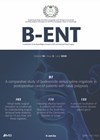
Journal Reviews archive for 2022
When to operate on a patient without chronic disease?
As ENT surgeons, we spend a lot of time managing chronic rhinosinusitis, so a review and update on the management of the acute disease is always helpful. The standard medical treatment of antibiotics, nasal steroids and nasal decongestants are reported...
Sublingual gland tumour resection
This paper from South Korea analyses the pathology arising from 20 malignant sublingual gland tumours. Adenoid cystic carcinoma followed by mucoepidermoid carcinomas were the most common. Tumour invasion into the lingual nerve was detected in 40% of cases, and into...
Clinical pathological features associated with malignant change in oral leukoplakias
This is a retrospective study from Sweden where 234 patients, diagnosed between 2003 and 2013 with a median nine-year follow-up, were reviewed. Of these 234 patients, 11.5% developed oral squamous cell carcinoma. Non-homogenous leukoplakia showed a 15-times higher transformation rate...
Can surgery make you a better driver?
Obstructive sleep apnoea is a condition that can have far reaching health, economic and safety implications for the individual inflicted with the condition, as well as those in their immediate and wider surroundings. Having the freedom to drive taken away...
Laryngeal disorders associated with HIV infection
Following the introduction, and now widespread availability, of combined antiretroviral therapy, HIV has become a chronic disease with minimal or indeed no negative impact on life expectancy. As a result, there is a growing public health interest in establishing the...
Serum biomarkers for CRSwNP
This cross-sectional comparative study looked at 50 patients with nasal polyps who, at the time of diagnosis, also had a blood test evaluating serum total IgE, IL-17 and Pentraxin-3. The study assesses whether these blood markers are useful in the...
Publishing - a predictor of an academic career in ENT?
Achieving a publication as a medical student renders ENT trainees six times more likely to publish again during postgraduate surgical training. But how does this correlate with subsequent subspecialty fellowship training and a career in academia? Johnson et al examined...
Robotic insertion of electrode array in cochlear implantation
Cochlear implants (CIs) are commonly used for profound bilateral hearing loss. They have specific national guidance for their insertion, however patients with a substantial residual acoustic hearing are potential CI candidates. Preservation of this residual hearing can be sought with...
Do personal listening devices cause cochlear synaptopathy?
Cochlear synaptopathy is a condition in which noise interrupts the synaptic communication between sensory inner hair cells and low spontaneous rate cochlear nerve fibres. Since these nerve fibres are associated with signal coding in noisy backgrounds, their disruption leads to...
Prognostic value of vascular ultrasonographic findings in patients with idiopathic sudden sensorineural hearing loss
Sudden sensorineural hearing loss is often idiopathic. Although the aetiology of idiopathic sudden sensorineural hearing loss (ISSNHL) is unclear, vascular compromise is one of the frequently proposed hypotheses to explain its pathophysiology. Existing studies have shown an association between ISSNHL...
Olfactory function and vitamin D
This Turkish prospective study evaluated olfactory function in individuals with primary vitamin D deficiency and the effect of replacement therapy on olfactory function over an eight-month period in 2019. A total of 91 individuals with vitamin D insufficiency were included,...
Tympanostomy tubes outcomes by tympanic quadrants- a meta-analysis
Tympanostomy tube (TT) insertion is one of the most common ENT procedures, resulting in millions of TTs being implanted per annum and occurring complications that need to be addressed. Premature TT extrusion (PTTE) is a well-recognised such complication, affecting almost...















